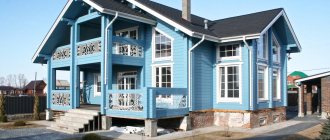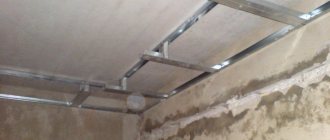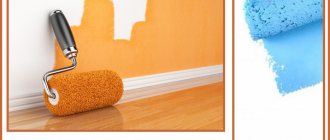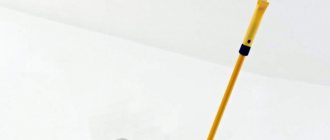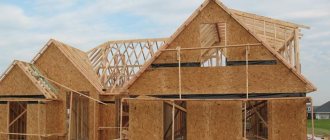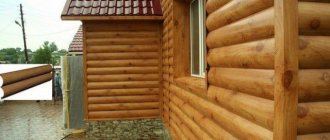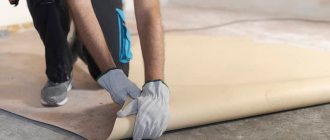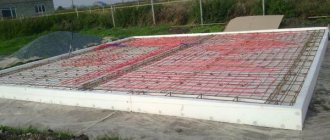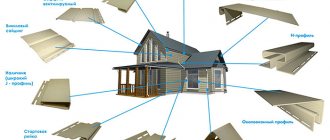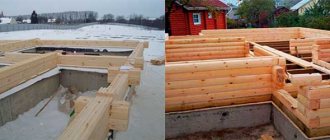Why do you need house painting?
Wood is a natural material, “living” and, like all living things, it has its enemies. Ultraviolet radiation, bark beetles, temperature changes. Precipitation, wind, snowfall. Availability of highways and industrial enterprises nearby. All this has a detrimental effect on the wood - it becomes coarser, loses its unique fiber structure, old paint (if the house was painted before) peels and cracks. That is, the house becomes outwardly unpresentable, has an unkempt and somewhat abandoned appearance.
This is where facade painting comes to the rescue. With it, without large capital investments, you can:
- refresh the facade of the house or reconstruct it so that you won’t take your eyes off it;
- eliminate visual defects;
- restore weakened protection of wood from negative atmospheric factors;
- prevent rotting and mold formation;
- maintain a comfortable microclimate inside the house.
From time to time, the facade of a wooden house requires updating. Painting exterior walls protects the wood and gives the building an attractive appearance.
What should be the façade paints?
Wood is a beautiful material, but not cheap, especially valuable species, and the main task of painting is to extend its longevity and slow down the aging process. Therefore, certain requirements are imposed on paint and varnish facade materials:
- environmental cleanliness and safety for others;
- weather resistance - resistance to ultraviolet radiation, high humidity, temperature fluctuations;
- bioprotection against fungus, wood insects and mold, which spoil the exterior of the house and thoroughly destroy it, sometimes, alas, irreversibly;
- long service life - the paint layer, if applied correctly, should last at least seven years, and when using products from branded manufacturers, up to ten or more.
Do not use products of dubious quality from unknown manufacturers. It often contains cadmium and lead - toxic substances that can cause severe poisoning not only at the painting stage, but even after some time until the toxic fumes completely disappear.
Video: how and what to paint the facade of a wooden house
Why paint?
As you might guess, not all people immediately wonder how to paint a wooden house. The fact is that there are more modern options than paint for the outside of a wooden house. So, why do many professionals adhere to the opinion that sometimes it is better to paint than to cover a wooden facade with any finishing material.
The first and most important advantage related to paint is its low price. Of course, it is best not to save on such things, but this advantage is very important, because people often spend almost all their money on basic work, and very little is left for finishing.
It is worth understanding that the method of painting the outer part of the walls will be inferior, for example, in fire safety and mechanical properties, to many materials intended for finishing. This drawback only applies to those situations when you decide to really save money, because the surface of the wood can be coated with fire retardants (they will cost you less than the difference in price). These modern means will help make the facade completely non-flammable.
Among other advantages of paint, it is worth highlighting that it is very easy to work with. Even a beginner, after studying materials on the Internet, will be able to answer questions about how to properly paint the outside of a wooden house, how to cover the surface of the facade, that is, what paints can be used to do this.
In fact, the answer to the question of what is the best way to paint a wooden house is complex, since the building materials market really offers a huge number of options, which can very easily get confused.
Note! Regarding the choice of material, it will also be best if you consult a professional. The fact is that there are a lot of criteria by which the choice must be made... We cannot say: “Coat with such and such paint” - after all, everything will depend, for example, on the climate of the region where you live, on your budget, which you are ready to spend on materials, from old paint or any other finishing (if you are not building a house, but are renovating its facade), from the material from which the house is made, and from much more
We cannot say: “Coat with such and such paint” - after all, everything will depend, for example, on the climate of the region where you live, on your budget that you are willing to spend on materials, on old paint or some other finish (in if you are not building a house, but are renovating its facade), on the material from which the house is made and on much more.
Types of facade paints
Paints for finishing facade works are divided into categories:
- covering ones, which after application completely hide the wood texture (or almost completely depending on the painting method);
Covering paints for exterior work allow you to mask all defects and a wooden house becomes like new - translucent - after their application, the wood texture remains visible, and sometimes even more pronounced;
Translucent facade paints preserve the structure of wood and provide a dramatic change in the appearance of the house - special primers - used before painting with the main color to hide defects or when painting dark wooden buildings in light colors.
When choosing paints and varnishes for facade finishing, pay attention not only to the manufacturer and type of paint. Consider colors and shades - pastel colors give buildings lightness and airiness, dark colors give nobility and solidity.
Paint and varnish coatings for facades differ in their composition. According to this gradation, they are water-based, oil-based or alkyd.
Acrylic facade paints
Acrylic paints (water-based) are aqueous dispersions of acrylic polymers. They form a coating with excellent adhesion to almost any surface, so when using it there is no need to specially prepare the base.
Advantages of acrylic paints:
- environmentally friendly and chemically safe;
- preserve the “breathing” properties of wood, increasing comfort in residential areas;
- durable and waterproof;
- resistant to mechanical stress and severe frosts;
- do not oxidize, therefore, do not lose their gloss and retain their original appearance for a long time.
It is advisable to apply acrylic paints to a previously unpainted and dry surface.
Disadvantages of acrylic paints:
- low abrasion resistance;
- high price compared to other paints and varnishes.
A huge selection of colors and shades of acrylic paints allows you to create a multi-colored rainbow facade of a wooden house
Customer reviews about acrylic paints
If the paint is already peeling off, be sure to remove everything that is not firmly in place. Otherwise, when the fresh paint dries, it will tear it off the facade. They'll fall off together. If the old paint “sticks” firmly to the facade (tap, sand). The general rule is for alkyd-alkyd, for acrylic-acrylic. There are modern combined coatings that are suitable for both cases.
Irina
https://forum.vashdom.ru/threads/kakoj-kraskoj-luchshe-pokrasit-derevjannyj-dom.27656/page-2
It took a long time to choose. I wanted to kill two birds with one stone: buy good, budget paint. We were painting an old wooden house. For three years, nothing happened to the paint; it didn’t peel, crack, or fade. We are very pleased with the choice.
Svetlana1953
https://otzovik.com/review_2551280.html
Whatever paint you choose, I suggest you do this:
After adding filler to acrylic paint, the house glows at nightThat is, add a filler to it that allows it to glow in the dark
BlagoSvet
https://www.e1.ru/talk/forum/read.php?f=120&t=353804
Oil facade paints
Oil paints can be considered as an economical option. They are made on the basis of an organic solvent - turpentine, white spirit, solvent and synthetic or natural oils. Currently, the demand for oil dyes has dropped significantly. This is due to the unpleasant smell of the paint and the fact that it is difficult to apply another paint coating on top of it - when updating you will have to either strip the old layer down to the base, or use oil paint again.
Advantages of oil paints:
- inexpensive;
- saturates wood well;
- block moisture penetration;
- resist mechanical damage and abrasion.
Disadvantages of oil paints:
- quickly fade under the influence of sunlight and peel off;
- takes a long time to dry;
- Drying oil-based paints emit harmful substances when dry and tend to develop a yellow color over time (this is especially noticeable in rich, bright or very dark colors).
Professionals recommend using oil-based paints for temporary painting of exterior wood surfaces.
Painting with oil paints is still a very common option for renovating a façade.
Reviews of oil-based facade paints
For wood, it is better to use special paints based on an alkyd binder with linseed oil. They have a greater affinity for wood, absorb deeper (linseed oil), have good water-repellent properties and, as a result, provide more reliable protection than standard alkyd or water-based paints. Sadolin Domus and Olympus are just such colors. You will be pleased with the results of using both.
Wolf
https://www.mastergrad.com/forums/t89027-chem-pokrasit-staryy-derevyannyy-fasad/
Biofa is the oil you trust! Impeccable quality and ease of use! Our friends who tested the quality of Biofa oils more than 10 years ago!
Wooden façade coated with Biofa over 10 years ago has stood the test of timeWoodpro
https://forum.onliner.by/viewtopic.php?t=7095462&start=460
Antiseptic facade paints
The simplest of antiseptic coatings is lime paint, which craftsmen make themselves. Its disadvantage is that it is washed off by rain and dirt settles well on it. The advantage is low price, excellent vapor permeability and antiseptic properties - it protects the wood from fungus, moss and mold. Sold in a limited range of colors, although any pigment can be added. Making your own lime mortar and painting a wooden structure with it is a good way to save money.
Video: a super cheap way to paint the outside of a wooden building
Today there is a large selection of antiseptic varnishes and paints on the building materials market. Among the domestic preparations, “Aquatex”, “Bioks”, “Sotex” are known, which preserve the texture of wood. Glims-LesSil is a glazing impregnation that destroys fungus and prevents its formation in the future. This impregnation is easy to clean with soap and water, so maintenance is minimal. Popular Western antiseptics include Tikkurila, Valtti Color Satin, Valtti Color Extra, “breathable” Bondex and Mipa M Holz Lazur - a decorative glaze with excellent performance.
Customer reviews about antiseptic paints
Tikurilla is 100% better than Tex. But I wrote about Teknos, also a Finnish paint. It probably won't matter to you. But if someone is going to paint a new house, then it is better to pay attention to Teknos. Reasons 1) It is not produced in Russia. All paint is imported, at the price of Tikkurila 2) Tikkurila - paints of the “household” series. Teknos is industrial. Without going into details, the difference is that in the case of Teknos you get more paint for your money than in Tikkuril 3) Teknos has better primers for painting. But overall, both Tikkurila and Teknos are worthy paints.
Gribnick
https://forum.littleone.ru/showthread.php?t=6191046&page=2
Everything in the dacha was painted with aquatex, a little soup in the bathhouse and the earliest painting of the utility block with cofadex. We have been using Aquatex since 2005 due to its affordable price and ease of use. We always didn’t take extra, because... extra has a gloss, and from experience, matte impregnation peels less in the sun. Aquatex dries quickly in fairly warm weather, and in cool and rainy weather for several days. The main thing is to stir well and often. Do not leave it in unheated rooms for the winter, otherwise the jelly will be virtually unusable. We didn't try to match the color, because... If we are going to touch up the paint, then we paint the entire structure.
Natalia MSK
https://www.id4.ru/top/?r=kraska&u=aquatex
Alkyd facade paints
This group of paints is based on oil-modified alkyd resins.
Advantages of alkyd compositions:
- good moisture resistance;
- invulnerability to any climate change - can easily tolerate temperatures of -30 °C;
- a gradational aging process, as a result of which the wooden surface acquires a refined matte structure over time.
Disadvantages include:
- very fast drying - because of this, alkyd paints do not have time to be deeply absorbed into the wood, so the coatings are short-lived;
- low resistance to fading.
Alkyd paints are distinguished by very high elasticity and frost resistance - they can easily withstand severe frosts.
Often wooden houses are so beautiful that it is a crime to paint them. But they also cannot be left unprocessed, otherwise all the beauty will quickly be destroyed. In this case, varnishes are used, which give the structure even greater charm and reliably protect it from negative weather conditions. Popular shades are natural teak, well suited to roofs made of grayish tin or ceramic tiles, rosewood - a dark shade looks ideal with white plaster, mahon - in combination with a tiled roof in greenish tones, white acacia and golden pine.
The shade of the facade after treatment with varnish in the tone “golden pine” resembles the natural colors of coniferous wood
When choosing a varnish, you need to take into account the type of wood, since the same impregnation (impregnation) looks different on oak boards, spruce, and birch. But one thing remains the same - they all preserve wood perfectly.
Table: comparative characteristics of facade paints
| Types of paints | Water-based | Alkyd | Oily |
| Compound | acrylates, water | alkyd resins | drying oil |
| Moisture resistance | high | high | low |
| Color fastness | high | average | low |
| Frost resistance | high (-30 °C) | high (-30 °C) | low |
| Smell | No | specific | unpleasant |
| Dryability | fast, 4 hours | average, 8 hours | long, more than a day |
| Wearability | low | gradual | high |
| Smudges | No | No | Yes |
| Shine | intensive quality | average | not intense enough |
| Safety | environmentally friendly | average | toxic |
| Durability | high, up to 10 years | average, up to 7 years | low, up to 5 years |
How to paint the outside of a timber house to preserve the beauty of natural wood
A significant portion of manufacturers of façade paints and protective coatings for wood offer options that completely change the appearance of the material - they hide both the color and texture of the wood - and so-called “transparent” or “glazing” compositions. The second option is most suitable for people who want to paint a house made of timber and preserve the natural appearance of a wooden building and at the same time protect it from the negative influence of the environment.
As an example, we will give paints from some popular manufacturers with a possible palette of colors after finishing (pine wood is proposed as the base, as the most popular and cheapest).
Azure is a translucent glaze paint with protective properties; it can be thin, medium and dense.
What’s interesting is that if topcoat paints give a constant color and the number of layers has little effect on the tone, then glazing compositions allow you to get different shades depending on the number of layers.
Glazing compositions based on acrylic and acrylic-latex are not always called paints. Often these are complex compositions with a number of additional properties:
- antiseptic;
- antifungal;
- insecticidal;
- protection against cracking;
- and so on.
Important: both topcoat paints and glazing agents can produce glossy, semi-gloss and matte surfaces. The choice of one option or another depends on the desires of the owner of a wooden house, but in general, for buildings and parts made of wood, a matte or semi-matte effect is considered optimal - this makes the painted material more similar to natural, untreated.
Selection of façade paint by manufacturer
When choosing paint to renovate a facade, you will come across a huge variety of paint and varnish products - silicate, acrylate nanopaints, silicone, oil, etc., which are offered by numerous manufacturers. To at least somehow get your bearings, let’s make a rating of the most popular ones.
- "Belinka" (Belinka) Slovenia - decorative paints for exterior use, characterized by high penetrating ability. Price for 1 liter ≈ from 525 rubles.
“Belinka” is a water-based azure textured coating for long-term protection of wood from weathering and UV radiation - "Tikkurila" Finland - silicone-modified facade paints, acrylate, oil and base paints, are distinguished by their high safety and longevity, which makes the use of these paints very profitable. Price for 1 liter ≈ from 376 rubles.
Tikkurila paints are tested in the harsh Finnish climate. Such coatings perfectly withstand exposure to ultraviolet radiation, rain, snow and frost, maintaining their original color for many years. - "Alpina" Germany - the products of this company are intended for people who have no experience in painting work. Low cost and detailed instructions for use have made these paints the most popular in Germany. Price for 1 liter ≈ from 345 rubles.
Inexpensive and high-quality paints - true European quality at an affordable price - "Neomid" Russia - premium class products are excellent for painting new wood surfaces and previously painted ones. Price for 1 liter ≈ from 238 rubles.
Neomid products (Russia) are a reliable protector of wooden facades from biological damage, moisture, negative atmospheric manifestations and fire - "Senezh" (Russia) - high-quality tinted antiseptics with the addition of natural oils and UV filters. When applied, they do not leave smudges and are resistant to solar radiation. Shelf life up to 7 years. Price for 1 liter ≈ from 340 rubles.
Senezh paints (Russia) protect wood from ultraviolet rays, the double wax composition actively repels water, and natural oils promote deep penetration into the wood - Teknos Finland - quick-drying, odorless paints. In Russia, such lines as “Biora Balance”, “Kirye”, “Vintol”, etc. are in demand. Price for 1 liter ≈ from 760 rubles.
When using Teknos for exterior work, the color of the facade remains unchanged for years. The high elasticity of the coating and its ability to “breathe” are maintained. - “Rogneda” (Russia) - super-elastic paints that dry well, form a silky, perfectly smooth coating, and have a crack-free shelf life of at least 10 years. Price for 1 liter ≈ from 150–160 rubles.
All paint and varnish products of this company undergo full quality control in accordance with GOST ISO9001–2011 and do not have a harmful effect on the environment, human and animal health - Zobel (Germany) - Zobel has been in the building materials market for more than 60 years. The products are characterized by environmental friendliness, safety and low consumption to achieve first-class results. Price for 1 liter ≈ from 770 rubles.
The manufacturer guarantees protection of wooden surfaces for up to 12 years. In the manufacture of paints, light-resistant pigments are used to ensure resistance to ultraviolet radiation and fading. - Dulux (England) - durable, made by combining environmentally friendly water-based paints with durable alkyd coatings. Well-breathable, quick-drying, contain additives against rot and mold, are characterized by high adhesion to the surface and a wide variety of colors. Price for 1 liter ≈ from 739 rubles.
When applying Dulux paint, a durable, weather-resistant coating with high adhesion is formed. Used for painting wooden facades in any climatic zones - Yaroslavl Paints (Russia) - the company specializes in the production of tinted glossy varnishes for facade work that imitate the natural structure of wood. Price for 1 liter ≈ from 200 rubles.
“Yaroslavl Paints” are produced taking into account the climatic conditions of our fatherland. Therefore, facades painted with them “hold on” for a long time, delighting with an excellent appearance.
Video: paints for a wooden house
Reviews about manufacturers
Belinka has an excellent composition and you need to know how to prepare logs. My bathhouse has been standing for 4 years and the color of the logs has not even changed. I used the glaze composition Belinka No. 24
Arkady
https://www.id4.ru/top/?r=kraska&u=alpina
I had experience working with Dali for facades. Specifically it was Super Elastic. The façade of the house needed to be covered. The house is brick, but not finishing brick. Plastered and puttied with sand-free mixture. Everything is like inside, in general. Then acrylic primer in two layers. And paint. They applied it with rollers, tinting it slightly orange beforehand. It turned out nice. The paint performed well. The main thing is that it has time for polymerization, from 2 to 7 days. Then it actually becomes very stable and durable. At the moment, the façade is in its second year, one winter is behind us. Justified, for now.
Stroy_yes
https://www.allremont.ru/showthread.php?t=17205
Bought from Leroy in 2021 Deluxe Trade. I painted the imitation timber façade in June (it had been untreated since December 2015). I did everything according to the instructions. First, I primed it with slightly diluted paint (as recommended on the paint can itself). It began to crumble in August of the same year. And by the summer of this 2021, the entire façade had peeled off. Wasted money, wasted time. The façade is damaged.
Andrey
https://www.id4.ru/top/?r=kraska&u=dulux
Yaroslavl paints have recently made up for lost time. There are new, really high-quality materials. Of course, there is one parameter in which they are much inferior to foreign brands - environmental friendliness (cleaning varnishes and solvents). This question has been left aside for now, and quite correctly. My personal opinion is that the result of painting is much more important than whether, for example, the paint smells like Soviet kerosene or doesn’t smell like anything.
mstche
https://www.mastergrad.com/forums/t26169-interesnyy-reyting-emaley-prodavaemyh-v-rossii/
Comparison of painting with other types of finishes
For analysis, we will take the most popular materials and compare them according to the most noticeable parameters during operation. From the table you will see that paints for wooden facades are not a panacea for all occasions, but in many respects they are better and more practical than, for example, siding or ventilated facades made of porcelain stoneware.
| Dye | Siding | Block house | Brick | Porcelain tiles | |||||||
| Decorative properties | Perfectly preserves the texture and characteristics of the wood surface | Completely hides the base | High, imitates a rounded log | Completely covers the tree | Very decorative | ||||||
| Easy to install and apply | Very easy to apply, just need a brush or roller | Difficult to install, requires special tools | Difficult installation | Difficult installation, requires a concrete foundation | Difficult installation | ||||||
| Price | Cheapest finishing option | More expensive than any type of paint | More expensive than siding | One of the most expensive | As good as brick | ||||||
| Durability | 6-10 years | 20 years | 10 or more years | 50 years | 50+ years | ||||||
| Ability to hide design flaws | Virtually no hiding | Hides completely | Hides | Hides | Hides | ||||||
| Weather resistance | High, but depends on the choice of paint | High | High | The tallest | As good as brick | ||||||
| Resistance to mechanical stress | Resistant only to accidental scratches and impacts. | Does not protect, can be destroyed even with a slight blow | Average | High | The most durable of finishes | ||||||
From the comparison it is clear that the most budget option is painting the walls and other wooden elements of the facade. In terms of mechanical and fire-fighting properties, paint is inferior, for example, to porcelain stoneware or brick, but with the money saved when purchasing material and paying professional builders, you can buy the most modern fire retardants, which make wood completely non-flammable for several decades.
Based on the results of the comparative analysis, you can make a choice in favor of paint. Now you need to make another equally important decision - what paint to paint the outside of a wooden house. Manufacturers produce dozens of types of paints and varnishes intended for external woodwork, but only a few of them may be suitable for a wooden house.
It depends on the:
- house material (timber, logs, blockhouse, lining, chipboard, etc.);
- climate zone;
- type of previous finish;
- budget.
As for paint manufacturers, it is best to focus on well-known brands - Tikkurila, Dufa, Finncolor, Beckers, any of the brands that are part of the Akzo Nobel concern. But you should buy them in large retail chains or well-known online stores. Unfortunately, there are now a lot of fakes and outright hack work on the market, so if you decide to save a few rubles, you risk ruining your home and incurring significant financial losses - redoing poor-quality painting is a very labor-intensive and expensive process. You can find out what paint is best to paint the outside of a wooden house on the official websites of the manufacturers; if the paint offered to you is not there, then you should not buy it, even at the most attractive price.
Painting the facade of a wooden house
Wooden houses have been built in Rus' for a long time, and at all times, thanks to the unique texture and unique properties of wood, they have been in price. And beautiful, well-kept wooden houses - even more so. Let's take a step-by-step look at how to properly update the façade of a wooden house to make it look prestigious and elegant.
Preparing for painting
When thoroughly renovating a façade, it is impossible to do without thorough preparation of the surface.
- The previously painted wooden surface is cleaned of previous paint, mastic and dirt using a metal brush, sandblasting or scraper.
All contaminants are removed from the previously painted surface. Old paint and resin are removed with a spatula - Seal small cracks, repair or replace damaged areas of the facade.
- Existing mold or mildew is removed with special solutions, for example, Homeenpoisto jelly-like wood bleach.
- Then the surface is sanded, thoroughly washed with water and degreasing detergents to ensure better adhesion of the new paint to the surface of the house and dried.
Sanding the surface is necessary to apply an even and stable layer of paint.
Sometimes the old coating is removed chemically using paint removers. This process is labor-intensive, but the result is excellent, since the wood pattern is better preserved.
Method of applying paint and varnish coating
The painting process is usually divided into 2 stages - priming the facade surface and applying the final paint coating.
Priming cannot be neglected. The use of primer antiseptics extends the life of the exterior paintwork and protects the wooden surface of the building from future moldiness, the appearance of fungi, blue stains, moss, moisture penetration and the harmful effects of ultraviolet radiation.
- The first layer of any antiseptic primer is applied to the surface prepared in advance and left until dry (usually a day).
First of all, damaged and hard-to-reach areas are impregnated. - Level with finishing putties and prime again.
- After the primer has completely dried, cover the surface with paint (varnish) in at least 2-3 layers, drying each according to the instructions from class=”aligncenter” width=”600″ height=”450″[/img] At the preliminary stage of painting, logs are sometimes treated bleaching compounds
Tips and tricks
- Apply primer, varnish and paint in a longitudinal direction, starting from corners and hard-to-reach areas.
- On hot days or on the eve of rain, it is better not to paint. Suitable weather for work is cloudy, calm and warm.
- It is recommended to work with a brush with natural bristles - it takes longer, but gives a better result.
- The paint must be mixed well before starting work and during painting to avoid uneven color over the entire area.
- Before starting painting, to check the correctness of the chosen color, it is worth doing a test color on a small area.
- It is advisable to also tint the primer in a tone close to the chosen color.
- The ends of logs or boards are vulnerable places; they easily and quickly absorb water, so they should be primed and coated with several layers of varnish or paint.
Video: mistakes when painting wooden facades
Painting a house made of rounded logs
To determine the best way to coat galvanized logs, you should carefully read the manufacturers' instructions. The paint material for them must be resistant to sudden temperature changes and solar radiation, and also allow air to pass through well.
Algorithm of actions:
- Remove all protruding parts - window sills, trim and remove the old caulk.
- Free the house from previous coverage, if any. To do this, heat the old paint with a hair dryer and carefully remove it with a spatula.
- Sand the surface with emery cloth or a special grinding machine.
The surface of the walls of a log house is sanded with a manual sanding machine. - Wash, degrease and dry.
- Impregnate with all kinds of protective agents, drying each layer.
- Decorative paint coating is applied.
Apply paint to the walls of the log house only in the longitudinal direction
Video: sanding and painting a log house
How to paint a wooden facade with old paint
We examine the facade. If it is in decent condition - there are no cracks, the varnish and paint have not peeled off much, you can simply repaint it in the same or similar color. In this case, it would be good to use paint similar to the one previously applied.
If you are unsure or don’t know what kind of paint was used before, then determine it yourself - acrylate coatings have a leathery surface and crack in the direction of the wood fibers, and oil-based coatings cross them (with a cage). To be sure, roll up a small piece of old paint - when it cracks and breaks, it means that oil paint was previously used, if it remains intact, then acrylate paint.
- Remove loose layers of old paint.
- Sand the surface, rinse with water pressure and dry.
- Level, prime and paint.
What paint to paint the outside of the house: compatibility of the base and top coat
If the house has just been built or is lined with wood, the question of choosing paint is completely arbitrary - the wishes of the owners and their financial capabilities are taken into account. The situation is different for facades that were previously painted or exposed with another protective composition.
If possible, you should find out exactly what composition was used. Thus, oil paints can be applied to a surface previously treated with drying oil, but it is not advisable to apply it to a surface painted with water-based paint - poor adhesion is possible. Any other paint will not work on walls previously painted with oil paint or, especially, enamel. Even for oil paint, you will have to first clean the surface from the remnants of the old coating and sand it - all the irregularities will instantly appear under a layer of fresh paint.
It is also important to correctly select the preparatory composition - wood primer or impregnation - with the material chosen for finishing. Ideally, both substances should have the same manufacturer and be combined in components.
Video: technology for painting a wooden house
My own home is not only “my castle”. This is still capital. And for it to be highly rated, not much is needed - care and periodic updating. Paint and varnish coatings will reliably preserve wooden buildings for decades, revive and transform even the most dull facade. The main thing is to choose the best.
- Author: Valentina Trubich
Not ideal, but real))) Rate the article:
- 5
- 4
- 3
- 2
- 1
(7 votes, average: 2.9 out of 5)
Share with your friends!
Requirements for paints for wooden facades
The facade of the house is exposed to the sun, rain, snow, and wind. If we are talking about a wooden house, the following features of wood are taken into account:
- prone to rot;
- the ability to “breathe”, to let air pass through oneself.
Painting a wooden house has two functions: protective and aesthetic.
Therefore, the following requirements apply to paint for exterior decoration of wooden houses:
- Resistance to ultraviolet radiation, in other words, does not fade, maintains color saturation when exposed to the sun.
- Hydrophobicity is the ability to repel water, protecting wood from rotting.
- Vapor permeability, without which the advantage of wood - natural air exchange - will be reduced to nothing.
About the author Valentina Trubich
Not ideal, but real))) I just want to enjoy life! I don’t want to be rude, scandalous or prove anything to anyone, I don’t want to waste time communicating with those who are unpleasant to me, with people who don’t understand me, and trying to reach them. I don’t want to try to fit my thoughts into someone else’s head. I am busy! I want to live my (!!!) present. I just want to LIVE! Enjoy every moment, every smile of a passerby, every day, regardless of whether it is sunny or rainy. And I really don’t want to exchange this amazing life for emptiness, trifles and nonsense... View all posts by Valentin Trubich →
